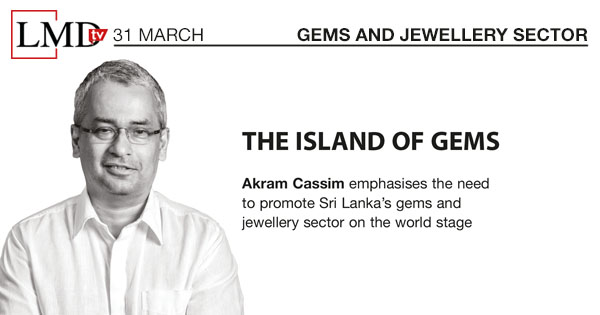LMD TV
“Trade was completely affected by the COVID-19 pandemic from March last year – with different segments being affected including the gems and jewellery sector,” said Akram Cassim – the CEO of Colombo Jewellery Stores – who noted that the sector encompasses exports, the local tourism industry and the retail market.
 Due to the pandemic, all three segments were impacted as exporters were unable to attend fairs abroad while tourism came to a halt and local retailers were affected by lockdowns imposed across the country.
Due to the pandemic, all three segments were impacted as exporters were unable to attend fairs abroad while tourism came to a halt and local retailers were affected by lockdowns imposed across the country.
“Every trader faced the same issues but we have fought back to rebound,” Cassim stated.
In his view, concessions in the form of eliminating income taxes and gold import duties were necessary to revive the sector as they hampered the trade, and the emergence of the pandemic made the sector’s recovery an arduous task.
As for Sri Lanka’s competitiveness compared to other gem exporting nations, Cassim believes that it is far behind: “We are a fabulous country with a history and heritage in the gems and jewellery sector. Some of the best sapphires that have been seen and worn around the world over the past 2,500 years have been from Sri Lanka.”
“This is called ‘the island of gems’ by many people as well as the ‘gem box of Asia’ – these names are because of our past,” he explained, adding: “We will have a future if we do a lot in terms of deregulation and other initiatives to improve the climate.”
According to Cassim, Sri Lanka should follow the example of Hong Kong, which is among the largest exporters of gems and jewellery despite not having any locally. However, it has built the sector through low taxes, deregulation and the ease of doing business.
Furthermore, he stressed the importance of deregulation to ensure that engagement with the sector is simple and easily accessible to businesses. Given Sri Lanka’s collection of gems and colourful history, he emphasised the need to capitalise on this and implement a long-term plan.
“We have gems and jewellery communities – from the miners to the cutters, to the craftsmen – and all these segments will suffer if there isn’t a long-term policy,” Cassim maintained, suggesting five to 10 years of low taxes, convenient export procedures and even simple online sales functions as potential initiatives to pave the way.
Expressing his views on moves to use unutilised plantations for mining, he stated that while Sri Lanka is full of gems, there is a need to carefully assess the environmental impact of mining as “we need to preserve what we’ve inherited.”
To this end, he asserted that appropriate assessments should be conducted before making this land available to the segments involved in an effort to avoid creating bare land, which could have implications such as intensifying the impact of floods.
As the sector looks to recover following several challenging years, Cassim cited the need to work with the tourism industry, noting that it should promote gems like it did from back in the 1970s.
“We need to revive this and work with Sri Lanka Tourism to drive the gems and jewellery sector,” he averred, explaining that tourists could spend thousands of dollars on these products, which could be considered as indirect exports.
“Given the prevailing foreign currency crisis, working with tourism is the quickest way to promote the gems and jewellery sector,” Cassim said, adding: “The Ceylon Sapphire is what we need to promote, which is among the oldest of its kind known in the world.”
Such an initiative could involve the cooperation of the gems and jewellery sector, tourism authorities, the Export Development Board (EDB) and embassies to elevate Sri Lanka’s sapphires although this calls for a consistent plan for the next five to 10 years.
“The sector is ready to help and all the associations can work together to guide the country forward; but we need a simple and constructive plan,” he assured in summing up.



